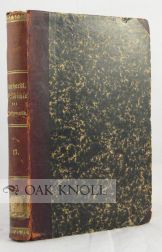NOVA METHODUS PRO MAXIMIS ET MINIMIS [in] ACTA ERUDITORUM ANNO MDCLXXXIV.
[as part of a run of volumes comprising Acta eruditorum years 1682 to 1685].
- Leipzig, Germany: J. Grossium & J. F. Gleditschium, typis Christophori Guntheri, 1682-1685.
- thick 8vo
- In contemporary German vellum binding, blued edges
- (xii), 402, (6); (viii), 561, (7); (ii), 591, (7); (vi), 595, (13) pages
Price: $25,500.00 other currencies
Order Nr. 131439
Text in Latin. Union List 1, 53. Four volumes (1682, 1683, 1684, and 1685) bound as one. Numerous diagrams and illustrations. Lacking the frontispiece for all four volumes. Errata follow text in each volume. A bit of marginal waterstaining at start. Hinges cracked, usual for a vellum binding of this thickness. Four dedication leaves misbound in Vol. I.. Plates XIX and XX out of sequence in Vol. I. Plate XI bound upside down in Vol II. Overall a lovely, clean copy.
Four volumes bound in one. Acta Eruditorum was the first scientific journal published in German-speaking lands, founded in 1682 by Otto Mencke, its first editor, and Gottfried Liebniz. It was published by Johann Friedrich Gleditsch. This set includes Volumes I-IV, 1682-5. First edition, as distinct from the often-confused second issuance of this work. Later continued by Otto's son, Johann Burkhard Mencke. Contains all of the Leibniz papers, including Nova Methodus Pro Morimus et Minimus, published in the 1684 edition (p. 467-473). This was the first announcement by Leibniz of his invention of differential and integral calculus, initiating a revolutionary development in mathematics and physics. Through its adoption and elaboration by these and other contemporaries, calculus was soon firmly established in western mathematics.
Leibniz's paper famously preceded Newton's publication of his own discovery of calculus, and the question of whether Leibniz plagiarized Newton's unpublished work caused a lengthy furore in the scientific world; it is now recognized that both men discovered calculus independently. "The infinitesimal calculus originated in the seventeenth century with the researches of Kepler, Cavalieri, Torricelli, Fermat and Barrow, but the two independent inventors of the subject, as we understand it today, were Newton and Leibniz. The subsequent controversy in the early part of the eighteenth century as to the priority of their discoveries - one of the most notorious disputes in the history of science - led to an unfortunate divorce of English from Continental mathematics that lasted until the end of the first quarter of the nineteenth century. Although both Newton and Leibniz developed similar ideas, Leibniz devised a superior symbolism and his notation is now an essential feature in all presentations of the subject" (PMM).
The paper, just seven pages long, "was the first attempt to set out the rules governing infinitesimal procedures. The rules are introduced geometrically, translated into algebraic terms, and then redescribed in terms of differentials. This enables Leibniz to provide basic rules of addition, subtraction, multiplication, and division. Specifying rules for the manipulation of signs, depending on whether the ordinates increase or decrease, he moves to the behaviour of curves, leading him to introduce second-order differentials, and by these means he offers procedures for finding powers and taking roots... Nevertheless, it should be said that the programme advocated in Nova methodus was obscurely formulated, and the paper was so cautious in its presentation that it hardly mentioned infinitesimals at all. The programme was quickly developed by the Bernoullis and others, however, and the first textbook, Guillaume de l'Hôpital's Analyse des infiniment petits (1696), written under the guidance of Johann Bernoulli, is far more explicit" (Clarke & Wilson, p. 349).
The Acta Eruditorum was established in 1682, in imitation of the Journal des Savans, and ran till 1731. Published under the auspices of the Collegium Gellianum, with support from the Duke of Saxony, it covered a wide range of topics, including medicine, mathematics, physics, law, history, geography, and theology. The journal soon became the most well-known German publication of its kind. Contributors included Boyle, Leeuwenhoek, Bernoulli, Pascal, Huygens, Halley, and Descartes, alongside Leibniz.
Provenance: With the bookplate of private collector Joseph A. Freilich and Joseph Garamp on front pastedown. Bibliotheca Comle Borgettiana, Magerata (ex-libris stamp on title page of Vol. 1).
Heralds 109; Ravier 90; Norman 1326; Sparrow 130; Dibner 109; Grolier/Horblit 66a; PMM 160; Desmond M. Clarke & ?Catherine Wilson, The Oxford Handbook of Philosophy in Early Modern Europe, 2013.

![Order Nr. 131439 NOVA METHODUS PRO MAXIMIS ET MINIMIS [in] ACTA ERUDITORUM ANNO MDCLXXXIV. Otto Mencke.](https://oakknoll.cdn.bibliopolis.com/pictures/131439.jpg?width=768&height=1000&fit=bounds&auto=webp&v=1679345952)
![NOVA METHODUS PRO MAXIMIS ET MINIMIS [in] ACTA ERUDITORUM ANNO MDCLXXXIV.](https://oakknoll.cdn.bibliopolis.com/pictures/131439a.jpg?width=320&height=427&fit=bounds&auto=webp&v=1680040904)
![NOVA METHODUS PRO MAXIMIS ET MINIMIS [in] ACTA ERUDITORUM ANNO MDCLXXXIV.](https://oakknoll.cdn.bibliopolis.com/pictures/131439b.jpg?width=320&height=427&fit=bounds&auto=webp&v=1680040906)
![NOVA METHODUS PRO MAXIMIS ET MINIMIS [in] ACTA ERUDITORUM ANNO MDCLXXXIV.](https://oakknoll.cdn.bibliopolis.com/pictures/131439c.jpg?width=320&height=427&fit=bounds&auto=webp&v=1680040909)
![NOVA METHODUS PRO MAXIMIS ET MINIMIS [in] ACTA ERUDITORUM ANNO MDCLXXXIV.](https://oakknoll.cdn.bibliopolis.com/pictures/131439d.jpg?width=320&height=427&fit=bounds&auto=webp&v=1680041162)
![NOVA METHODUS PRO MAXIMIS ET MINIMIS [in] ACTA ERUDITORUM ANNO MDCLXXXIV.](https://oakknoll.cdn.bibliopolis.com/pictures/131439e.jpg?width=320&height=427&fit=bounds&auto=webp&v=1680041165)
![NOVA METHODUS PRO MAXIMIS ET MINIMIS [in] ACTA ERUDITORUM ANNO MDCLXXXIV.](https://oakknoll.cdn.bibliopolis.com/pictures/131439f.jpg?width=320&height=427&fit=bounds&auto=webp&v=1680041167)
![NOVA METHODUS PRO MAXIMIS ET MINIMIS [in] ACTA ERUDITORUM ANNO MDCLXXXIV.](https://oakknoll.cdn.bibliopolis.com/pictures/131439g.jpg?width=320&height=427&fit=bounds&auto=webp&v=1697504108)

